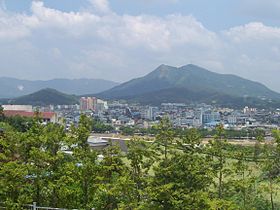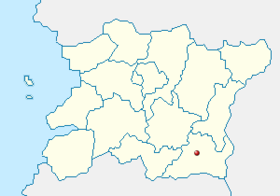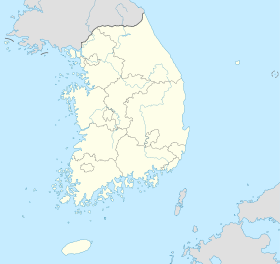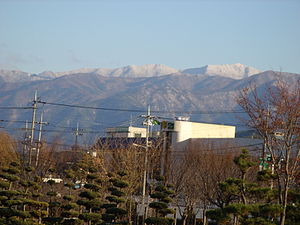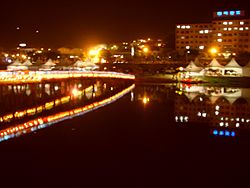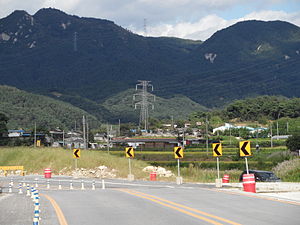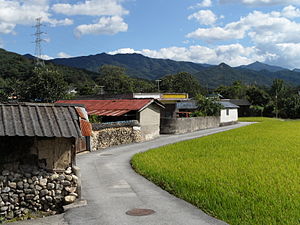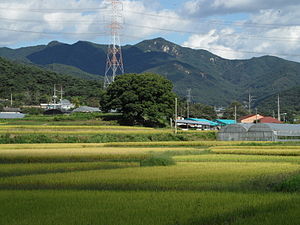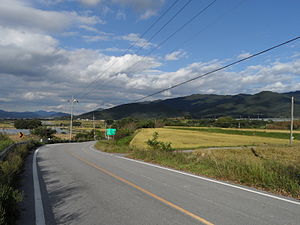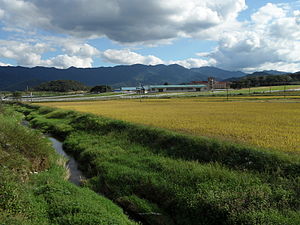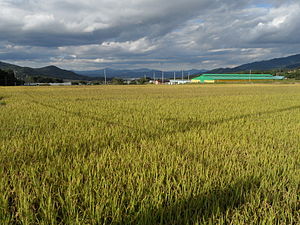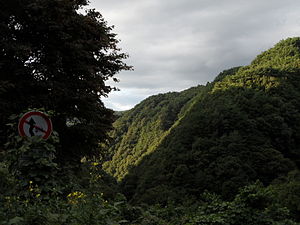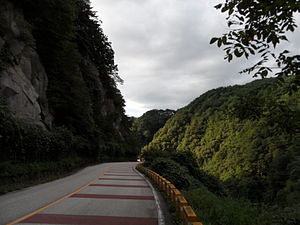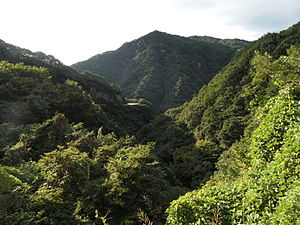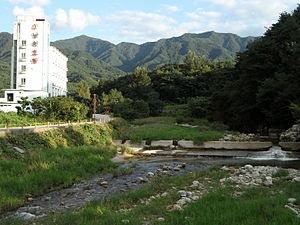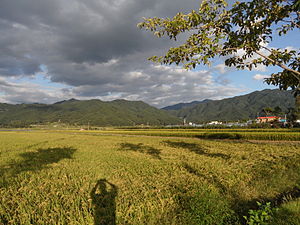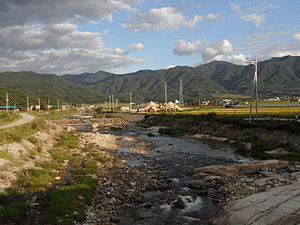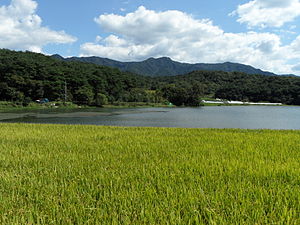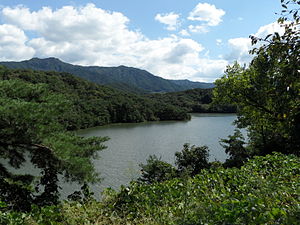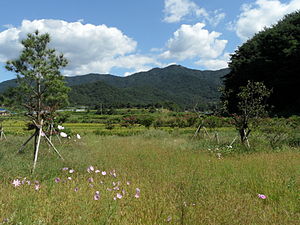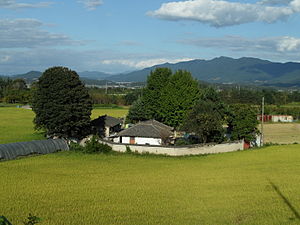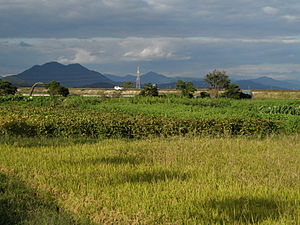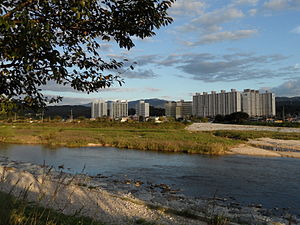- Namwon
-
Namwon
남원— Municipal City — Korean transcription(s) – Hangul 남원시 – Hanja 南原市 – Revised Romanization Namwon-si – McCune-Reischauer Namwŏn-si Namwon City 
Emblem of NamwonLocation in South Korea Coordinates: 35°24′36″N 127°23′9″E / 35.41°N 127.38583°E Country  South Korea
South KoreaRegion Honam Administrative divisions 1 si, 15 myeon, 9 dong Area – Total 752.12 km2 (290.4 sq mi) Population (2009) – Total 88,496 – Density 117/km2 (303/sq mi) – Dialect Jeolla Namwon (Namwon-si) is a city in North Jeolla Province, South Korea. Namwon is about 45 minutes from the provincial capital of Jeonju, which is three hours away from Seoul.
The official city flower is Royal Azalea (철쭉) while the city tree is the crape-myrtle (배롱나무) and the city bird is the swallow (제비).[1]
Namwon is a small city located just outside of Jirisan National Park, which has the largest set of mountains on the South Korean Mainland. It is 3 and a half hours from the Seoul Central City Bus Terminal and about one hour from both the U-Square Bus Terminal in Gwangju and the Jeonju Inter City Bus Terminal. It is called "the City of Love" because of the famous Korean love story of Chunhyang. Gwanghallu Garden is a shrine to this love story.
Contents
History
Namwon was founded in 685 during the reign of King Sinmun of Silla Kingdom. Namwon county was founded on April 1, 1895.
The city suffered during the Siege of Namwon in 1597 which was part of the Imjin War. During the siege that lasted from August 13 to August 16 the only defenders against the Japanese army of 56,000 men were 3300 Korean and Chinese soldiers and 6000 women and children. In the end the Japanese found a way to enter the city and killed all the soldiers and civilians.
Geography
Namwon is located in a basin bordered by the Sobaek Mountains to the east and the Buheung Mountain Ridges to the west with the Yocheon River flowing through the city. Namwon is bordered by the counties of Imsil and Sunchang to the west, Jangsu to the north, Hamyang and Hadong in Gyeongsangnam-do to the east, and Gurye and Gokseong in Jeollanam-do to the south.
Climate
The average yearly temperature of Namwon is 12.3℃ with the average temperature in January being -1.4℃ and 25.2℃ in August. Due to its location in a mountainous basin with a high rate of precipitation, the climate of Namwon varies greatly. Winds in Namwon are usually weak and blow north to west in the winter and south to west in the summer. However, temperatures can sometimes (briefly) drop below -10℃ in January. Temperatures in July can often reach 33℃. Temperatures in spring (April and May) and fall (September and October) are often in the mid 20's℃ and with low humidity.
Climate data for Namwon (1981−2010) Month Jan Feb Mar Apr May Jun Jul Aug Sep Oct Nov Dec Year Average high °C (°F) 5.0
(41.0)8.2
(46.8)13.2
(55.8)19.9
(67.8)24.6
(76.3)27.9
(82.2)29.9
(85.8)30.6
(87.1)27.3
(81.1)21.9
(71.4)14.5
(58.1)7.4
(45.3)19.2 Daily mean °C (°F) −1.4
(29.5)1.0
(33.8)5.6
(42.1)11.9
(53.4)17.4
(63.3)22.0
(71.6)25.0
(77.0)25.2
(77.4)20.6
(69.1)13.4
(56.1)6.5
(43.7)0.4
(32.7)12.3 Average low °C (°F) −6.8
(19.8)−5.2
(22.6)−1.3
(29.7)4.0
(39.2)10.4
(50.7)16.7
(62.1)21.1
(70.0)21.1
(70.0)15.2
(59.4)6.6
(43.9)0.2
(32.4)−5.2
(22.6)6.4 Precipitation mm (inches) 31.2
(1.228)41.0
(1.614)52.5
(2.067)71.5
(2.815)111.0
(4.37)176.7
(6.957)298.9
(11.768)346.1
(13.626)137.0
(5.394)46.3
(1.823)42.8
(1.685)25.4
(1)1,380.4
(54.346)% humidity 71.9 67.5 64.8 62.1 66.6 72.5 79.1 78.8 75.6 73.9 73.4 74.2 71.7 Avg. precipitation days (≥ 0.1 mm) 8.4 7.1 8.3 7.7 8.9 9.8 14.9 15.5 8.4 5.9 7.1 7.3 109.3 Sunshine hours 157.5 175.0 203.0 222.1 223.5 182.9 159.0 176.4 181.2 197.6 162.7 156.0 2,199.3 Source: Korea Meteorological Administration [2] Culture
Chunhyang festival
The annual four-day Chunhyang festival commemorates a legendary love story and folktale, Chunhyangga. This festival is said to be the oldest in Korea.[citation needed]
According to the legend, Chunhyang was a maiden who was taken advantage of by an immoral local governor who forced her to marry him while the young man she really loved was away on government affairs. When the young man returned he disguised himself as a common person and saw for himself the myriad of injustices that the local governor had perpetrated; using his authority to kill him, things are set straight and the maiden is set free, giving the tale a happy ending.
The main bridge that crosses the river that runs through the middle of the city is lit up, and along the river bank there are vendors selling food and items of all kinds. The Chunhyang beauty contest can be entered by the most beautiful female residents, in traditional dress. Another event is the Chunhyang parade which runs through cordoned sections of the city along the river bank, and which comprises just about the entire complement of the city's mid-grade schoolgirls (numbering probably in the low hundreds) who are dressed in full chogori and carry musical instruments of some type, and who march in a very long line. There are also other parades of men and anyone else who is not a young girl may dress up in traditional dress and join the procession. The festival lasts four days and fireworks are launched every night.
For the rest of the year when the festival is not on, there is a small theme park dedicated to Chunhyang (Namwon Tourist Complex) complete with hypothetical dwellings and surroundings that someone like Chunhyang would have had (a mock house and yard). There are other sights in the park unrelated to Chunhyang such as a fish pond where visitors are free to feed the fish and some old-fashioned swings and horseshoe-style throwing games. Outside the park, along the river bank, there are also mini paddle boats that people can rent to traverse the small river.
Sights
- Mangbok Temple Site, constructed between 1046 and 1083 during the rule of King Munjong of Goryeo
- Silsangsa Temple, a Buddhist temple
- Gwanghallu Garden, a traditional garden that symbolizes the universe (commonly attributed to the Chunhyang story)
- Cheongheobu Gate, the main entrance to Gwanghallu Garden
- Wanwoljeong Pavilion
- Chunhyang Shrine, built in the memory of Chunhyang
- Wolmaejib House
- Chunhyanggwan Hall
Additional Pictures of Namwon area
Sister cities
 Lompoc, United States
Lompoc, United States Seocho, South Korea
Seocho, South Korea Yancheng, China (since June 13, 1998)
Yancheng, China (since June 13, 1998)
References
- ^ 상징물-남원시청
- ^ "평년값자료(1981−2010) 남원(247)". Korea Meteorological Administration. http://www.kma.go.kr/weather/climate/average_30years.jsp?yy_st=2011&stn=247&norm=M&x=19&y=4&obs=0&mm=5&dd=2. Retrieved 2011-05-02.
See also
North Jeolla 
Capital Cities Counties Metropolitan cities of South Korea Special city Metropolitan cities Provincial capitals with gus
(not included above)Provincial capitals without gus
(not included above)Cities with gu
(not included above)Cities
(not included above)Andong · Anseong · Asan · Boryeong · Chungju · Dongducheon · Donghae · Gangneung · Geoje · Gimcheon · Gimhae · Gimje · Gimpo · Gongju · Gumi · Gunpo · Guri · Gunsan · Gwacheon · Gwangju · Gwangmyeong · Gwangyang · Gyeongju · Gyeongsan · Gyeryong · Hanam · Hwaseong · Icheon · Iksan · Jecheon · Jeongeup · Jinju · Miryang · Mungyeong · Namwon · Namyangju · Naju · Nonsan · Osan · Paju · Pocheon · Pyeongtaek · Sacheon · Samcheok · Sangju · Seogwipo · Seosan · Siheung · Sokcho · Suncheon · Taebaek · Tongyeong · Uijeongbu · Uiwang · Wonju · Yangju · Yangsan · Yeongcheon · Yeongju · YeosuCategories:- Cities in Jeollabuk-do
Wikimedia Foundation. 2010.

